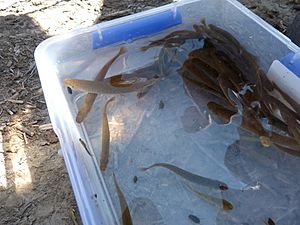Canterbury mudfish facts for kids
Quick facts for kids Canterbury mudfish |
|
|---|---|
 |
|
| Conservation status | |
 Nationally Critical (NZ TCS) |
|
| Scientific classification | |
| Genus: |
Neochanna
|
| Species: |
burrowsius
|
The Canterbury mudfish (Neochanna burrowsius), also called the kowaro, is a special fish. It lives only on the Canterbury Plains in New Zealand. This small, flexible fish doesn't have scales. It can even survive out of water in damp spots when its home dries up in summer.
The first Canterbury mudfish was studied in 1926. A farmer named Mr. A. Burrows found them and sent them to a scientist, W. J. Phillipps. The fish arrived alive after a long journey in a damp tin box! The mudfish is named after Mr. Burrows, even though it's known for hiding in holes.
Contents
What They Look Like
The Canterbury mudfish has a long, flexible body. Its fins are small but a bit thick. It has a small, rounded head with tiny eyes and mouth. It also has small tube-like nostrils.
Unlike some other mudfish, the Canterbury mudfish keeps its very small pelvic fins. These fins are usually missing in other similar fish. Each pelvic fin has only 4 or 5 rays, which are like tiny bones, instead of the usual 7.
Adult mudfish often grow to about 120 mm (about 4.7 inches) long. Some can even reach 150 mm (about 5.9 inches). They are usually light or milky brown. They have darker spots that spread onto the fleshy parts of their back fins. Sometimes, they even have small gold flecks.
Where They Live
Canterbury mudfish live in an area from just north of Christchurch down to the Waitaki River. Today, you can find them in springs, water races (small channels for water), and drains.
Long ago, they lived in the many wetlands of the Canterbury Plains. But most of these wetlands were drained for farming. This changed where the mudfish could live.
How They Survive Dry Times
Canterbury mudfish are amazing because they can survive even when their watery homes dry up. People have known this since they were first discovered. Mr. Burrows first noticed them because they would reappear every spring in a creek that was dry all summer.
When he dug in the banks, he found fish inside "holes shaped like a coconut." Each hole had a small opening. The holes were very smooth inside. They could hold water for a long time if the fish closed the entrance carefully. In experiments, Canterbury mudfish have lived for 85 days out of water!
When their wetland home starts to dry, the water can become still and low in oxygen. If the oxygen level drops too much, mudfish start to "air-breathe." They take a bubble of air into their mouth and get oxygen from it. While doing this, they stop using their gills. This means they absorb oxygen directly through the skin inside their mouth. During this time, they stay very still. They might hang at the surface or dig into the mud. Some mudfish even choose to leave the water if it has too little oxygen.
When the water dries up completely, Canterbury mudfish keep getting oxygen from mouthfuls of air. They also absorb oxygen through their skin. Even though their body processes slow down, they stay active. They often change position, roll onto their backs, and group together. They stay aware of their surroundings. This helps them react to changes and move to damper spots, instead of going into a deep sleep like some hibernating animals.
Life Cycle
Canterbury mudfish lay their eggs in late winter and spring. They scatter their small eggs among thick water plants near the surface. If the water quality or plants aren't right, they can wait to lay their eggs.
The tiny baby fish, called fry, hatch two to three weeks later. They are about 5–7 mm long when they hatch. At first, they are active during the day in open water. But when they grow to about 35–50 mm, they start acting like adult mudfish. They become active at night and spend most of their time hidden.
They grow quickly in their first year, usually reaching 75-80 mm. After that, their growth slows down. They can have babies in their first year. Female mudfish lay eggs once a year, producing anywhere from 500 to 10,000 eggs!
Protecting the Canterbury Mudfish
The Canterbury mudfish is in danger. In 2014, the New Zealand Department of Conservation said it was "At Risk: Nationally Critical." This means its numbers are expected to drop by more than 70% in ten years. Also in 2014, the IUCN called the Canterbury mudfish "Critically endangered."
There are not many Canterbury mudfish left, and they live in only a few places. So, protecting them depends on special efforts. Their numbers are decreasing mainly because of:
- Taking too much water from their habitats.
- More intense farming, which changes their environment.
- Changes in irrigation systems.
People are working to help these fish. For example, some Canterbury mudfish were released into a protected wetland near Willowby, south of Ashburton, New Zealand. It is hoped they will live and have babies there. In May 2010, 90 young fish were also released into Travis Wetland in Christchurch. The goal was for them to settle there and grow their population.


